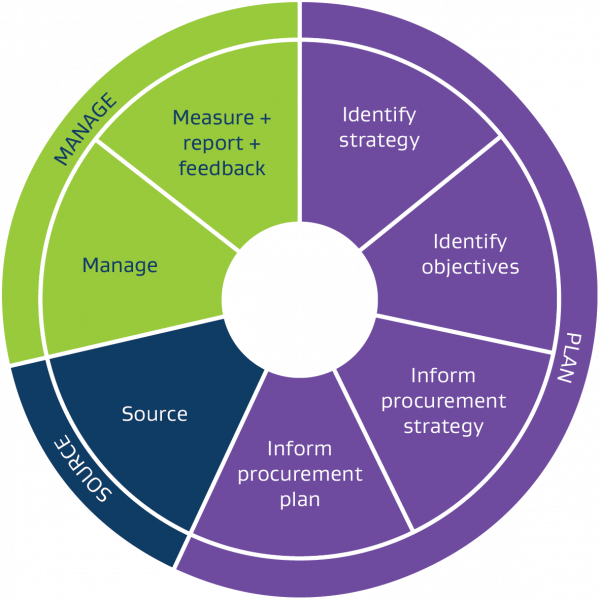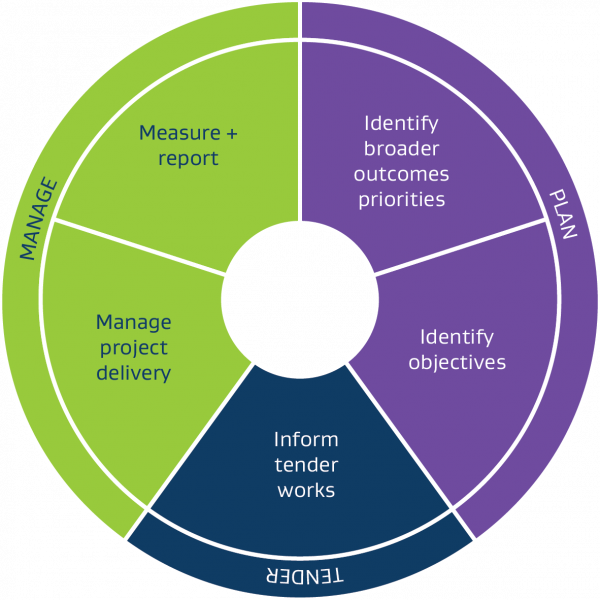Include broader outcomes into your secondary procurement processes
When running a secondary procurement processes (SPP) it is important that you give access to New Zealand businesses, including Māori, Pasifika and regional businesses, as well as social enterprises. There is a lot that agencies can do to make it easier for businesses of all sizes to compete and ensure a level playing field in government procurement.
Increasing access for New Zealand businesses
Professional services broader outcomes framework for agencies

Agencies can lean on this framework during the procurement stages, as it’s been designed to:
- Complement and build on the Government’s broader outcomes objectives
- Enable consistency and transparency in definitions, processes and expectations
- Complement and build on existing broader outcomes advice by agencies such as Waka Kotahi New Zealand Transport Agency and Auckland Council.
Framework for delivering broader outcomes — Waka Kotahi New Zealand Transport Agency [PDF, 4.16 MB]
Sustainable procurement — Auckland Council
The Accord — Construction Sector Accord
It’s a good idea to look at the framework elements and key considerations together rather than in isolation as you work through the plan-source-manage steps.
Plan
When you develop your procurement objectives, strategy and plan, consider the following to give your procurement project the best chance of success:
- Work early with your stakeholders and define your broader outcomes strategy.
- Define your broader outcomes objectives and incorporate them into your business-as-usual (BAU) procurement planning.
- Agree with your stakeholders on outcomes and a methodology/approach for delivery.
- Agree on key performance indicators (KPIs) and targets with your providers. Make sure to call out benefits and timelines. You can use baselines and regional demographic data as metrics for your KPIs.
Source
During the sourcing stage, you can:
- Make sure your stakeholders know and agree to their roles and responsibilities.
- Looking for opportunities to purchase from Māori enterprises, Pasifika businesses, social enterprises and suppliers that have good environmental, social, and cultural practices.
- Make sure you have included guidance in your procurement to help your providers deliver their best response. You can use the smarter micro-framework: specific, measurable, achievable, relevant, time-bound, ethical, and recorded.
- Consider using evaluation criteria to recognise businesses with relevant (developing) capability that match your procurement outcomes.
- Make sure your evaluators have sufficient understanding of broader outcomes and how they add value to your procurement. It is highly recommended that evaluators have experience in identifying and evaluating broader outcomes on other projects.
- Incorporate broader outcomes into your negotiations through KPIs and timeframes.
Manage
During the delivery of broader outcomes, you can:
- Collect data through reporting or engagement sessions to help measure success.
- Work closely with your suppliers to enhance delivery of broader outcomes and supplier capability.
- Ask for progress reports on agreed or required measures. These could include incentives or penalties based on performance.
It is also a good idea to review the performance of current contracts to inform subsequent procurement activities by:
- Identifying future needs
- Identify constraints and next-level supply chain broader outcomes, and
- Support optimisation and continuous improvement.
Professional services broader outcomes framework for providers
Broader outcomes are incorporated in the Government Procurement Rules and require government agencies to consider specific outcomes when buying from designated contract areas. Businesses who tender for government contracts should consider these broader outcome priority areas when submitting their tender applications.
Broader outcomes
Broader outcomes have become increasingly significant and relevant in public sector procurement with higher weightings in some cases, therefore, it’s important that businesses who tender for government contracts view broader outcomes as:
- More than a line item and integrate relevant experience, capabilities and case examples in their tenders.
- An opportunity to highlight innovative approaches in stakeholder engagement, design, delivery and reporting. Businesses should look for areas where their service offerings align and integrate with the needs of government agencies.
- A unique selling point.
- A way to develop trust and long-term relationships with government agencies and other stakeholders such as community groups, iwi groups and mana whenua.
Plan
Before you submit your tender, you should have a good idea of what broader outcomes agencies are looking for and how your expertise and skills will meet the requirements:
- Identify broader outcomes opportunities with government agencies to pursue.
- Identify the priority outcomes that your business can deliver, considering your available skills, capability and other resources.
- Work with internal and external stakeholders early to define broader outcomes objectives for projects.
- Include key performance indicators (KPIs) and targets against identified outcomes. This can be done separately by the procurement teams or with the preferred provider(s).
Read our tips for when you’re planning to tender:
Planning to tender
Tender
When you prepare your tender, consider the following:
- Stakeholders know their roles and responsibilities.
- Consider sub-contracting/sub-consulting to medium or small businesses who have capability or are developing capability, to deliver defined outcomes.
- Look for opportunities to include Māori businesses, Pasifika businesses, social enterprises or suppliers that have good environmental, social, and cultural practices.
- Incorporate and prepare for broader outcomes in negotiations. Call out associated costs, benefits and timelines.
Read our tips about responding to tenders and what to include in your response:
Submitting a tender
Manage
To keep things running smoothly:
- Measure success by identifying and calling out key data through reporting and engagement sessions.
- Consider approaches for managing risk appropriately and collaborative methods for delivery of broader outcomes.
- Work with appropriate reporting structures or available data sources before the start of the project.
- Make sure you have reporting mechanisms available across your supply chain.
- Confirm you have met the contractual obligations relating to broader outcomes.
Find out more about managing contracts, relationships, dealing with issues and what to do at the end of a contract.
Manage the contract
Broader outcomes framework questions
Here are a few broader outcomes questions you could use in RFx documents and evaluation criteria as part of the procurement process. The broader outcomes rationale tool will help you to identify what good look likes through weighting criteria and specific questions around broader outcomes.

